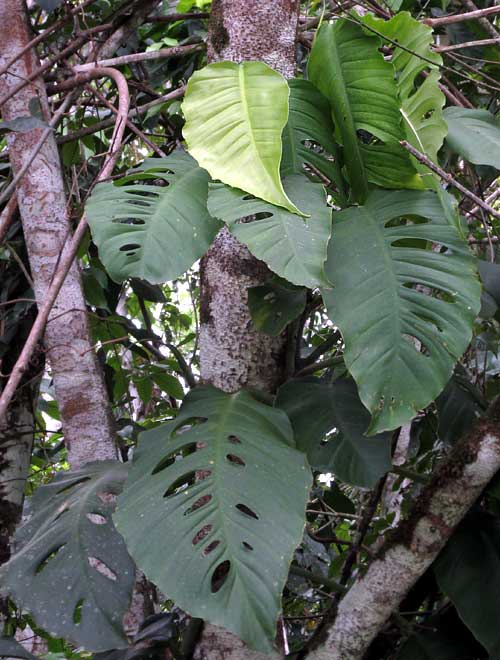Excerpts from Jim Conrad's
Naturalist Newsletter
from the April 24, 2016 Newsletter with notes from a visit to Lacanja Chansayab in the Lacandon Reserve; elevation 200m (650ft), N16.604°, W90.917°; Chiapas, MÉXICO
MONSTERA VINE
One of the most conspicuous differences between roadside forest in lowland Chiapas and in the Yucatan Peninsula is that the much greater annual rainfall in Chiapas creates a taller forest with a shadier, more species-rich understory. Foremost among the most eye-catching plants in this shady understory are the viny aroids -- an aroid being a member of the Arum or Jack-in-the-pulpit Family, the Araceae. In general, aroids with their large, often glossy and somewhat fleshy leaves need ample rain and humidity. Yucatan forests also contain viny aroids, but nothing close to the number and diversity of those in Chiapas.
One common aroid vine often seen climbing trees in Chiapas's Lacandon Reserve, around the town of Lacanja Chansayab, is shown below

The feature making this species easy to identify is that its leaves, which can reach 65cm long (over 2ft) on stems climbing tree trunks to 30 meters high (almost 100ft), bear oblong holes in them. Often leaves of other climbing aroid species are deeply cut from the margins, but having holes completely surrounded by leaf blade is unusual. Most amateur aroid admirers immediately associate such holes with the genus Monstera.
Knowing the genus, despite having no flowers or fruits, the vine could be identified as MONSTERA ACUMINATA, thanks to Michael Madison's 1977 "A Revision of Monstera (Araceae)," freely downloadable from http://www.aroid.org/gallery/gibernau/1979/Monstera%20revision%20-%20Madison%201977.pdf
In that publication, Madison writes the species is easy to identify because of its "somewhat falcate laminae pendent from the erect petioles." The word falcate describes something that's sickle-shaped, and laminae are leaves. He's talking about the way the leaves' midribs curve so that blade tips point to the side.
Monstera acuminata, which doesn't seem to have a good English name, is distributed from east-central Mexico south through lowland northern Guatemala and Belize into Honduras. In the Lacandon Reserve it's commonly encountered.